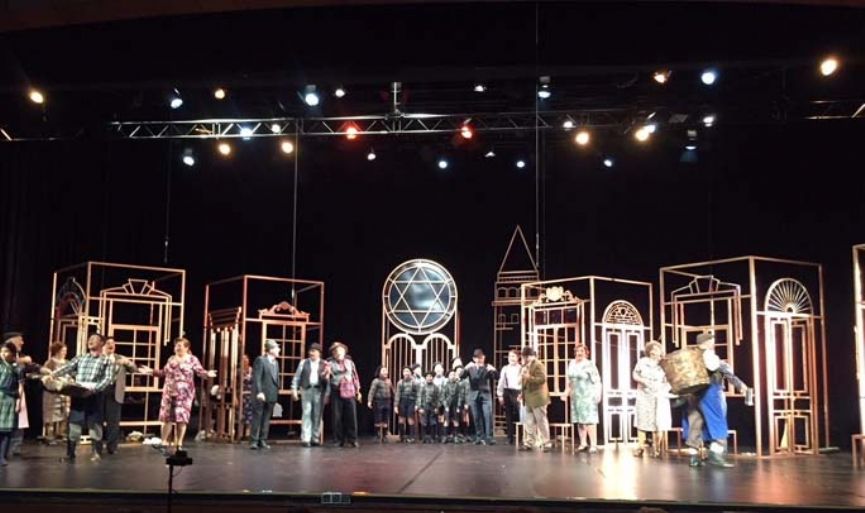
Kula 930 On Stage for One More Performance

Musical play Kula ‘930 that was put on stage in December 2017 at Fulya Art Center will be put on stage once again, upon huge demand. The proceeds from the previous three performances were donated to an education fund. We talked with Karen Gerson Sarhon, one of the actors, about the musical play which was originally put on stage 40 years ago and its revival. The play reached nearly 2.000 viewers with three performances, in December.
Could you give us information about the background of the play?
For the Turkish Jewish Community, Kula '930 musical play has become a classic with its 40 years of history. When it was first put on stage in 1977-1978 at Dostluk Jewish Community Center, it had 75 performances, a record in the history of Jewish community. For its 10th anniversary in 1987-1988 and its 25th anniversary in 2002-2003, overall the musical play was put on stage nearly for 100 performances. The play had reached approximately 8.000 viewers. This year, at the play’s 40th anniversary, we have reached 2.000 more viewers. In the history of our community, there is no other play that has attained such a spectacular success.
What made this play so successful?
The most important feature of the musical play Kula '930 is that it is performed in Judeo-Espanyol/Ladino language, a language which was once the most significant part of our community’s ethnic identity. Only the young actors are speaking Turkish in the play. All songs are performed in Judeo-Espanyol.
It’s very doubtful this musical will be put on stage in the coming years. Even the present cast (most of which consist of the core cast from 40 years ago) has come to a certain age. Therefore, young generations, academics, all parties around the world concerned with Judeo-Espanyol, universities and thousands of people in Israel and the World who know and speak this language will not have the chance to see this play. This musical play is a part of Sephardic culture and it is a live reflection of Turkish Sephardic community in the early 20th century. It is also a historical archive as well as a good example to show how the last generation who spoke this language strives to protect this language.
The plays made a tremendous impact after being staged. I’m sure you’ve received many feedbacks. Would you share these feedbacks with us?
The musical play that was put on stage at Fulya Art Center for three performances on December 16 and 17 reached 2.000 viewers. After the last performance, we received a lot of requests for more performances from people who were unable to see the play and from people who were outside Istanbul at the time of the performances. They were sad that they had missed the performances and said that they would see it if it was staged one more time. Even some of the people who saw the play said that they wanted to see the play one more time.
Costumes that were designed down to the last detail and a decor that was simple yet modern fascinated the audience…
There were two elements in this production that were handled by professionals: decor & lighting and contribution to music. These professional contributions increased the quality of the play at least tenfold. The decor was amazing, but what made it even more amazing was the lighting. Such a splendor was created on stage that it made the audience go back in time to 1930’s Kuledibi. The common feedback we received about the decor was that it was simply “amazing”. Actors are a better judge of the positive impact of lighting in a play, but in the eyes of the audience good lighting creates magic on stage. That’s why in this production, the stage was magical.
As for the costumes, Forti Barokas came to our rescue like a hero and brought most of the costumes from her home where she keeps a theater archive. Initially, we interviewed a professional costume designer, but our budget was not enough to cover his fee. The actors also came to our rescue. Everybody oversaw their own costume. As for accessories, our heroes Forti Barokas, Suzi Gozcu Eskenazi and Bivet Nasi went to Eminonu (Old City of Istanbul), Grand Bazaar, Beyoglu (Pera) in search of accessories. The feedback from the audience regarding costumes were like “How did you manage to find those dresses, those hats, those shoes... Hats off to you all!”
Of course, we should not forget the director of the play…
Of course, I want to talk about Ferit Koen, the director of the play. He is a professional theater director, but when it comes to community events, he prefers to work as a volunteer. He is a super-talented man. He directed Kula '930 based on his own imagination and boosted the quality of the play. He highlighted elements of humor mixed with elements of tragedy and drew the spotlight on the characters. He had the patience of a saint. It takes real courage and patience to direct a play where almost all actors are older than you. Ferit managed to overcome all these challenges.
Conclusion: On its 40th anniversary, Kula ‘930 was put on stage and the performances were impeccable. You might wonder if were there any mishaps. Of course, there were. How could there be not? First of all, the sound system was inefficient. The ones sitting in the far back had hard time hearing the dialogues since the theater hall was so big. The second mishap was the over-script system. We translated the whole play to Turkish, but since the over-script projector was delivered late, we did not have enough time to embed the whole translated script into the system. Over-script system was supposed to be ideal for those who do not speak Judeo-Espanyol, so they were a little disappointed. We are planning to fix these issues for the upcoming performances.
Related Newsss ss













